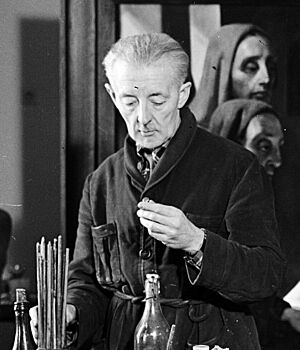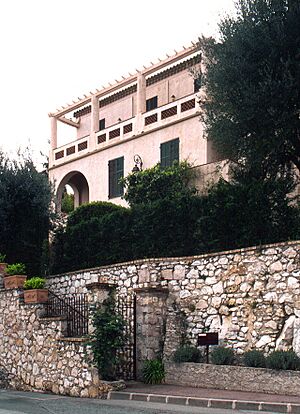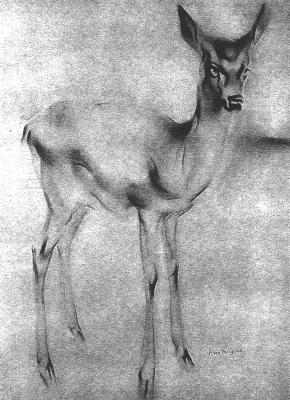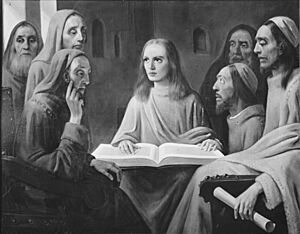Han van Meegeren facts for kids
Quick facts for kids
Han van Meegeren
|
|
|---|---|

Van Meegeren painting Jesus Among the Doctors in 1945
|
|
| Born |
Henricus Antonius van Meegeren
10 October 1889 Deventer, Netherlands
|
| Died | 30 December 1947 (aged 58) Amsterdam, Netherlands
|
| Occupation | Painter, art forger |
| Spouse(s) |
Anna de Voogt
(m. 1912; div. 1923)Jo Oerlemans
(m. 1928) |
| Children | Jacques Henri Emil |
Han van Meegeren (born October 10, 1889 – died December 30, 1947) was a Dutch painter. He is known as one of the cleverest art forgers of the 20th century. Van Meegeren became famous after World War II. People learned that he had sold a fake painting to Hermann Göring, a high-ranking Nazi leader. This happened during the Nazi occupation of the Netherlands.
Van Meegeren wanted to be a successful artist. However, art critics did not like his original paintings. So, he decided to prove his skills by creating fake paintings. He copied famous artists from the Dutch Golden Age. Important art experts, like Dr. Abraham Bredius, believed his fakes were real 17th-century artworks.
During World War II, Göring bought one of Van Meegeren's "Vermeers." It became one of Göring's most prized possessions. After the war, Van Meegeren was arrested. He was accused of selling valuable art to the Nazis. To avoid a severe punishment, Van Meegeren confessed. He admitted that the painting was a fake. He was found guilty on November 12, 1947, and sentenced to one year in prison. Sadly, he died on December 30, 1947, after two heart attacks.
Contents
Early Life and Art Training
Han van Meegeren was born on October 10, 1889, in Deventer, Netherlands. He was the third of five children. His father, Hendrikus Johannes van Meegeren, was a teacher.
When Han was young, he met Bartus Korteling, a painter. Korteling became Han's teacher and friend. He taught Han about the painting methods of Johannes Vermeer. Korteling did not like modern art styles. This might have influenced Van Meegeren's own views on art.
Van Meegeren's father did not support his love for art. He wanted Han to study architecture. So, in 1907, Han went to the Delft University of Technology. He also took drawing and painting classes there. He was good at architecture and even designed a boathouse for his rowing club. This building still stands today.
In 1913, Van Meegeren stopped studying architecture. He chose to focus on drawing and painting. He went to art school in The Hague. In 1913, he won a special Gold Medal. This award was for his excellent drawing of a church interior.
On April 18, 1912, Van Meegeren married Anna de Voogt. She was also an art student. Their son, Jacques Henri Emil, was born later that year.
Becoming a Painter
In 1914, Van Meegeren moved his family to Scheveningen. He earned a diploma from the Royal Academy of Art. This allowed him to teach art. He worked as an assistant professor.
To earn more money, Han drew posters and painted pictures. He made Christmas cards, still-lifes, and portraits. Many of these early paintings are now quite valuable.
Van Meegeren had his first art show in 1917. In 1919, he joined the Haagse Kunstkring. This was a special group for writers and painters. He painted a famous picture called Hertje (The Fawn). It was a portrait of a tame roe deer belonging to Princess Juliana. This painting became very popular in the Netherlands.
He traveled to many countries, like Belgium, France, and England. He became known for painting portraits. Rich people from England and America hired him. They liked his skill in using 17th-century painting methods. Van Meegeren always signed his own paintings with his name.
Van Meegeren and Anna de Voogt divorced in 1923. He then focused on painting portraits. He also started making forgeries to earn more money. In 1928, he married actress Johanna Theresia Oerlemans. She had a daughter, Viola, who joined their family.
Art Critics and Forgeries
Van Meegeren was a well-known painter in the Netherlands. But some art critics said he was only good at copying other artists. They said he lacked his own original style.
One critic wrote that he was "a talented artist who copied the Renaissance style. He has every good quality except being original." Van Meegeren did not like these comments. He wrote angry articles in a magazine called De Kemphaan. He wanted to prove the critics wrong. He decided to create a masterpiece that would fool everyone.
Creating the "Perfect Forgery"

In 1932, Van Meegeren moved to a mansion in France called "Primavera." There, he worked on his plan to create perfect forgeries. He bought real 17th-century canvases. He also made his own paints using old recipes. He used materials like lapis lazuli and white lead. This made sure his paints looked authentic. He even made his own paintbrushes, like those Vermeer used.
Van Meegeren discovered a special trick. He used a type of plastic called phenol formaldehyde (Bakelite) in his paints. This made the paint harden quickly, making the paintings look 300 years old. After painting, he would bake the canvas in an oven. This hardened the paint and created cracks. Then, he would rub black India ink into the cracks. This made the cracks look old and dirty.
It took Van Meegeren six years to perfect his methods. He was very happy with his results. He painted two practice forgeries in the style of Vermeer. These were Lady Reading Music and Lady Playing Music. He did not sell these. They are now in the Rijksmuseum.
After a trip to Berlin in 1936, Van Meegeren painted The Supper at Emmaus. He used an old 17th-century painting as a base. He also studied a painting by Caravaggio for inspiration. He gave his new "Vermeer" to a friend, who showed it to Dr. Abraham Bredius.
In 1937, Dr. Bredius examined The Supper at Emmaus. He believed it was a real Vermeer. He called it "the masterpiece of Johannes Vermeer of Delft." Tests on the painting seemed to confirm it was real.
The painting was bought by The Rembrandt Society for a lot of money. It was then given to the Museum Boijmans Van Beuningen in Rotterdam. In 1938, it was a main attraction at an art show for Queen Wilhelmina. Many people thought it was the most important painting there.
In 1938, Van Meegeren moved to a large estate in Nice, France. He bought it with the money from his fake Vermeer. He painted more forgeries there, including two in the style of Pieter de Hooch. He also painted Last Supper I in Vermeer's style.
He returned to the Netherlands in 1939 as Second World War began. He continued to create forgeries, including The Head of Christ and The Washing of the Feet. These were also in the style of Vermeer. His forgeries earned him a huge amount of money. He used it to buy many houses and a luxurious lifestyle.
The Göring Forgery
In 1943, Nazi leader Hermann Göring hid his stolen art collection in a salt mine in Austria. Among these artworks was a painting by Van Meegeren. In May 1945, Allied forces found the art.
Investigators traced the painting back to Van Meegeren. On May 29, 1945, he was arrested. He was accused of helping the enemy and selling Dutch art. He faced a serious punishment. Van Meegeren then confessed. He told them the painting in Göring's collection was a fake. He said, "The painting in Göring's hands is not a Vermeer, but a Van Meegeren! I painted the picture!"
It took time to check his story. Van Meegeren was held for several months. To prove his claim, he painted another forgery. He created Jesus among the Doctors in the style of Vermeer. He painted it while watched by reporters and court officials. After finishing it, he was moved to a prison. He was released in early 1946.
Trial and Conviction
Van Meegeren's trial began on October 29, 1947, in Amsterdam. The charges of helping the enemy were dropped. This was because the painting sold to Göring was a fake. It was not real Dutch cultural property. Instead, he was charged with forgery and fraud.
An international team of experts examined Van Meegeren's paintings. They included scientists and art experts. They found that his paints contained modern materials like Bakelite. This plastic was not invented until the 20th century. This proved the paintings could not be old.
The experts also noticed that the cracks in the paint looked fake. They seemed to be filled with India ink. This would not happen naturally. Also, the paint was very hard, unlike old paint. These findings confirmed that the artworks were forgeries.
On November 12, 1947, Han van Meegeren was found guilty. He was sentenced to one year in prison. The trial was widely reported. Van Meegeren became a kind of folk hero in the Netherlands. People saw him as a clever trickster who fooled art experts and even Göring.
Death
While waiting to go to prison, Van Meegeren's health got worse. He had a heart attack on November 26, 1947. He was taken to a hospital in Amsterdam. He had a second heart attack on December 29. Han van Meegeren died on December 30, 1947, at age 58.
After his death, his belongings were sold at auction. The money was used to pay back those who bought his fakes and to pay taxes. His last painting, Jesus among the Doctors, sold for a small amount. Today, it hangs in a church in Johannesburg.
Later Investigations
After Van Meegeren's death, some people still argued about his paintings. A Brussels art expert, M. Jean Decoen, believed some of the "Vermeers" were real. He even sued Dr. Paul Coremans, who had proven the fakes. However, the court sided with Coremans. He showed that a "Vermeer" painting had an older painting underneath it. This older painting had been bought by Van Meegeren.
In 1967, scientists at Carnegie Mellon University examined more "Vermeers." They used new methods to test the paints. They confirmed that the paintings contained modern materials. For example, the white paint used by Van Meegeren had different elements than old Dutch white paint. This proved they were forgeries.
In 1977, Dutch labs did more tests. They used advanced techniques like gas chromatography. These tests again confirmed that six of the "Vermeers" were indeed Van Meegeren's fakes.
Legacy
In 2008, art historian Jonathan Lopez wrote a book about Van Meegeren. He suggested that Van Meegeren made forgeries mainly for money. He needed money to support his fancy lifestyle.
Van Meegeren's father once told him, "You are a cheat and always will be." Yet, Van Meegeren was also seen as loyal and generous by his family. He even sent a signed art book to Adolf Hitler.
After his release from prison, Van Meegeren continued to paint. He signed his new works with his own name. His fame as a forger made his original paintings sell quickly. They sold for much higher prices than before. He even claimed he had an offer to paint portraits in the U.S. for a lot of money.
In 1947, a poll showed Van Meegeren was one of the most popular people in the Netherlands. The Dutch people admired him for tricking art experts and Hermann Göring. Göring was reportedly shocked when he learned his "Vermeer" was fake.
Van Meegeren's trial defense was very clever. He made himself seem like a true Dutchman who wanted to trick the Nazis. He remains one of the most ingenious art forgers of the 20th century. After his trial, he said, "My triumph as a counterfeiter was my defeat as a creative artist."
Known Forgeries
Here is a list of some of the known forgeries by Han van Meegeren. Most of them were made in the style of Vermeer.
- The Happy Smoker (1923), after Frans Hals. It is now in the Groninger Museum.
- Man and Woman at a Spinet (1932).
- Lady reading a letter (1935–1936). It is on display at the Rijksmuseum.
- Lady playing a lute and looking out the window (1935–1936). It is on display at the Rijksmuseum.
- The Supper at Emmaus (1936–1937). Sold for a very high price.
- Interior with Drinkers (1937–1938).
- The Last Supper I (1938–1939).
- The Head of Christ (1940–1941).
- The Last Supper II (1940–1942).
- The Blessing of Jacob (1941–1942).
- The Washing of the Feet (1941–1943). Sold to the Netherlands state, on display at the Rijksmuseum.
- Jesus among the Doctors (September 1945). Painted during his trial.
- The Procuress. Confirmed as a fake in 2011.
Van Meegeren's forgeries have been shown in exhibitions worldwide. This has made them available for the public to see.
Potential Forgeries
It is possible that other fake paintings by Van Meegeren exist. His son, Jacques van Meegeren, suggested his father made more forgeries. Some possible fakes include:
- Boy with a Little Dog and The Rommelpotspeler after Frans Hals.
- A copy of Vermeer's Girl with a Pearl Earring. A painting called Smiling Girl in Washington, D.C., is recognized as a fake. It might have been painted by Van Meegeren.
- Lady with a Blue Hat after Vermeer. Its current location is unknown.
Original Artwork
Van Meegeren was a very productive artist. He created thousands of his own original paintings. He painted in many different styles. This variety often confused art critics.
His original works include classical still lifes and Impressionistic scenes. He also made humorous drawings and Surrealist paintings. However, his portraits are often considered his best original works.
His famous painting Deer is an example of his original art. Other works include his award-winning St. Laurens Cathedral and a portrait of his second wife, Jo Oerlemans.
Fakes of the Forger
After Van Meegeren became famous, his own original paintings became more valuable. This led to people making fake Van Meegeren paintings. They would add his signature to existing paintings or create new ones in his style. Van Meegeren joked that he would have accepted them if they were good enough.
Later, his son, Jacques van Meegeren, also started to fake his father's work. These fakes were not as good quality. Many fake Van Meegeren paintings are still on the market today.
Images for kids










